Great shot
Tips from the pros
Tips from the pros
Mike Fizer and Chris Rose present "AOPA and the Art of Aviation Photography" on Saturday, Nov. 13, at AOPA Aviation Summit in Long Beach, Calif. Fizer will also be a host at a Thursday night "Dine Around" with editors from AOPA Pilot. See the website.

The art of aviation photography—particularly air-to-air photography—has advanced tremendously since AOPA Pilot was launched more than a half-century ago, and the pace of change is accelerating with digital and video equipment adding exciting new capabilities. AOPA staff photographers, who are at the forefront of these changes, talk about their approaches to this dynamic photographic niche and their tools for delivering the best possible aviation images.
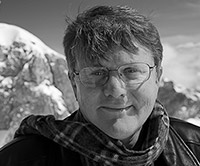 Mike Fizer
Mike Fizer
Age: 51
Education: Assistant to aviation photographer Paul Bowen, 1978-1982
AOPA: 22 years
“I start every assignment by thinking about the character of the airplane I’m going to shoot and the aspects of it I’d like to emphasize, and then I find a background that fits its personality. If it’s a backcountry airplane, mountains would be appropriate. If it’s a float plane, an expansive setting on a lake with glassy water would be right. A jet might call for a tight power angle in flight.
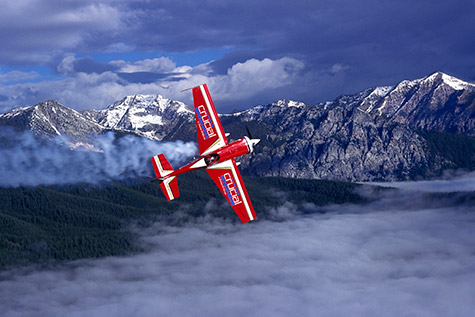
Mike Fizer photographed Greg Poe’s aerobatic maneuvers in his 300L over the Sawtooth Mountains in Idaho.
“For air-to-air shoots it’s very important for the pilots to have civilian or military formation experience and training. I generally let the pilots do their briefing first so they can talk about airspeeds, frequencies, and airspace. The pilot briefing should be all about logistics and safety. If they don’t talk about what to do if they lose visual [contact] then I pop in. I make sure they know that if I lose sight of the subject airplane I’ll notify the platform pilot right away [via intercom]. And if both pilots have lost sight, I expect them to call out their altitudes and make sure there are no conflicts before they attempt to rejoin.
“When it’s my turn to brief, I describe my hand signals and radio calls and the positions they can expect me to put them in. My commands are left and right; up and down; forward and back. I let them know we’re going to do lots of 360s, and lots of configuration changes with the gear and flaps. If there’s anything I ask for that they consider unsafe, the pilots must know it’s OK not to do them. I’m thinking about the shots I want. They have to know the capabilities of their airplanes.
“My favorite time in a photo flight is after the takeoff when you look out and can see that all the planning has paid off.”
—Mike Fizer
“There’s no real correlation between a pilot’s total flight time and ratings and whether or not they’re good at photo flying. I did an air-to-air shoot with the chief pilot [of an airline] and he was totally unable to put his airplane in position. I’ve also flown with relatively low-time pilots who had a real knack for it. Some pilots like this type of flying and look forward to it, and others don’t. It’s definitely not for everyone.
“I typically carry two lenses on air-to-air shoots: a 24/105 zoom, and a 70/200. With those two lenses, I’ve got the flexibility to create the feel I’m looking for, whether it’s a wide landscape or a tight power shot. Shutter speeds are generally between a sixtieth and a two-hundred- fiftieth of second. A faster shutter speed tends to freeze the prop, and that just doesn’t look right. On rare occasions I’ll use a five hundredth of a second if stability is a problem.
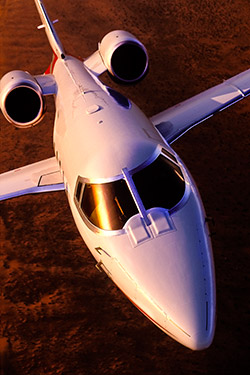
A Lear 60 photographed by Fizer over Yuma, Ariz., sand dunes from the tail of a B-25.
“I try very hard not to shoot through glass. But if it’s unavoidable, I’ll wear a black, long-sleeved T-shirt to reduce reflection, and I’ll try to shoot 90 degrees through the glass to minimize distortion. Sometimes I’ll tape a four-foot black cloth around the inside of the window and shoot through a slit in the cloth.
“My absolute favorite airplane to shoot from is a B–25. It’s a great platform because the tail-gunner position provides an unobstructed 180-degree view, and you can get head-on shots of the subject airplanes from wing tip to wing tip. The waist-gunner positions are also great, and the nose-gunner position allows a view from behind through optical glass. It’s the ultimate platform—but it costs about $2,000 an hour.
“Barons and A36 Bonanzas can fly with the right-side aft doors off for the left-side view of the subject airplane. And some Pipers can fly with the left-side doors off, and that provides an aesthetically better view of the subject airplane. Say what you will about a T-tailed Piper Lance, but it’s a great photo platform.
“The act of shooting a camera is much like shooting a gun in that you have to be stable to be accurate. If I’m not stable, or the camera’s moving, the results will suffer.
“The best times of day to shoot are early in the morning and late in the evening—the first and last hour of daylight. Digital photography extends that time a bit to the first and last 90 minutes. Low light allows shadows to form over the subject airplane, and those shadows and reflections make the images more interesting. Clouds kick up the color, and so does water where you can shoot down and get reflections.
“My favorite time in a photo flight is after the takeoff when you look out and can see that the planning has paid off and all you have left to do is the photography. Then the adrenaline starts pumping, and I like to close my eyes and take a few deep breaths to settle down and get my game face on. Even after doing it for all these years, I still get excited. It’s still challenging, and I enjoy the anticipation and the teamwork.
“What we do is unusual. It’s fun and interesting, and there’s a great deal of teamwork that goes into it, as well as a little danger. I feel quite charmed to get to do the things we do. It’s hard work and there’s lots of travel and long hours. But when it’s over, I can’t wait to get back out there and do it all again.”
 Chris Rose
Chris Rose
Age: 39
Education: Shepherd University (graphic design and photography)
AOPA: 17 years
“I went on my first photo mission in 1996 as a ride-along with Mike Fizer and found it incredibly exciting. Two airplanes in close formation, out over the Chesapeake Bay on a summer evening with the doors off and the wind blowing—and you’re right there in the open door. I’d always been fascinated with aviation, and I’d done photography my whole life, so this was a way to combine two of my favorite things in one activity.
“Mike is incredibly open, and he doesn’t hold on to trade secrets. He took time to explain what he was doing and why he was doing it. My background was in graphic design, and my transition to photography was gradual and very gentle. I had my first photo published in 2003 and slowly started doing more of it. What I like about photography is that there’s a singular moment of capture. Your decision is final. I like the absolute clarity of it. You go with your instincts and try to make your best decision first, because you may not get another opportunity.
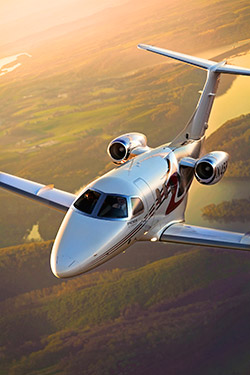
This Embraer Phenom 100 was Rose’s first photo shoot of a jet.
“My approach to video is much the same as photography in terms of lighting and aircraft positioning. I like the fact that my camera [Canon 5D Mark II] allows me to take high-definition video as well as still images. It’s like an extension of my arm, and the video is very photographer-friendly, so it’s not nearly as intimidating to me as a professional video camera.
“I particularly like seeing people’s reactions to video because they’re so immediate. But I get the same sense of satisfaction from making a good video that I do from a good still image.
“I shoot with a gyrostabilizer on my camera that I’ve come to regard as essential equipment. The gyro allows me to use slower shutter speeds, and that lets me shoot in lower light. My advice to people getting started in photography in regards to equipment is to spend money on good lenses first. If you can only afford one lens, get a 24/70 or a 24/105.
“I like to show an airplane within a space, and that means showing the background. If you’re too tight you lose that. Water is my favorite background because it gives a sense of depth. Airplanes are complex machines, and a complex background tends to compete with them. Water is a smooth background that provides a contrast.
“What I like about photography is that there’s a singular moment of capture. Your decision is final. I like the absolute clarity of it.”
—Chris Rose
“Certain colors of airplanes and background tend to clash like plaids and stripes. I’m looking for contrast. An aircraft in a cloudless sky can be boring in the same way that a photo of a bird in a blue sky can be boring. Put the same bird in a tree with a lake and the photo is more interesting because it complements the bird and shows a relationship.
“The future for me is trying to be original and finding my own style. We’re experimenting with different photo platforms like the AirCam. And as cameras become smaller and the quality gets better we’re mounting them in different locations. We used to do photo shoots with only one still camera. Now it’s common for us to have multiple cameras in the photo platform as well as two or three more in the subject airplane.”
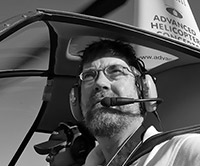 Mike Collins
Mike Collins
Age: 48
Education: Western Kentucky University (photojournalism)
AOPA: 16 years
“My background is in photojournalism. I worked as a newspaper photographer and editor before I got into aviation. One of the things I learned as a photojournalist is to arrive early and stay late. The best light of the day is during the first couple hours after sunrise, and the last hour or two before sunset. The sun is lower in the sky, and its effect on your subject is more striking. Those rays have to travel through a thicker slice of the atmosphere, which causes them to provide a warmer light.
“Plus, some of the most photographically interesting things happen when you least expect them. Preparation—for an event or just a flight—can provide more interesting angles, moments, or compositions than the activity itself.
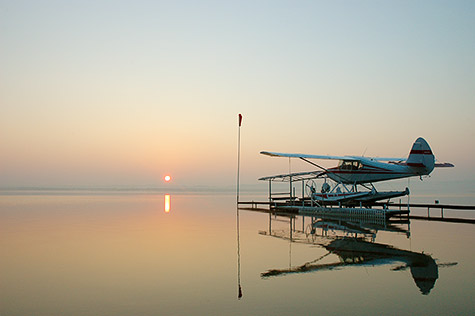
Mike Collins photographed this Aeronca Sedan on floats in Michigan in the early morning light.
“I finished the shoot of an Aeronca Sedan on floats in Michigan one evening, but I didn’t leave for home until noon the next day. I noticed that the airplane was moored on the west side of a lake, so the sun would rise behind it. When the pilot remarked that mornings on the lake had been foggy, I decided to get up early and drive back to the dock before dawn. The sun rising through the mist made for some of the best photos of the trip.
“It’s also good to previsualize what you want to achieve. Think ahead so you can get what you want. Take a night airshow. You know generally what’s going to happen—airplanes flying in the dark with lights or pyrotechnics, and you know approximately where they will be. Find an aircraft you can silhouette in your composition, to put the scene into context—otherwise it may look like just another photo of fireworks. Use a long exposure, 20 or 30 seconds, and trip the shutter when the airplane reverses direction so the light show can work its way across your shot. Pop a few flashes on the foreground while the shutter’s open, to add more depth and visual interest.
“When I shoot an air-to-air mission, I like the results to reflect the way the subject airplane is normally operated. I wouldn’t shoot a Cirrus or a turboprop flying low over the terrain—but that’s what I might look for when the subject’s a Cub, an LSA, or other low-and-slow airplanes. High-performance aircraft look great above a cloud layer, if the weather cooperates. Otherwise I like to shoot up at them, against a blue sky, to give a sense of altitude—even if we’re only a few thousand feet above the ground.
“Some of the most photographically interesting things happen when you least expect them.”
—Mike Collins
“A lot of photographers talk about ‘clean’ backgrounds, and those can be very effective—that means there’s nothing distracting behind your subject. I like to step back a bit, and show enough background to put my subject in context. Whether it’s an airplane or a person, the right background can tell the viewer a lot more of the story.
“My primary camera today is a Nikon D300S, and I normally carry three zoom lenses that cover the range between 11 mm and 200 mm. But I don’t obsess about equipment. A photographer’s most important tools are his eyes and his brain.”


